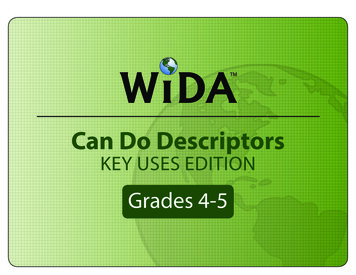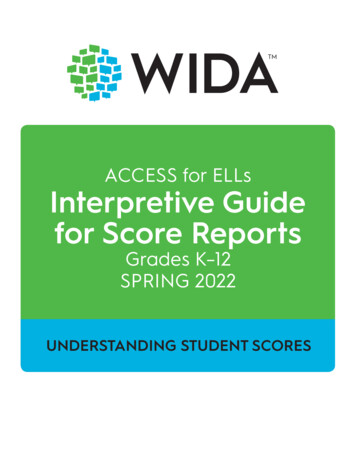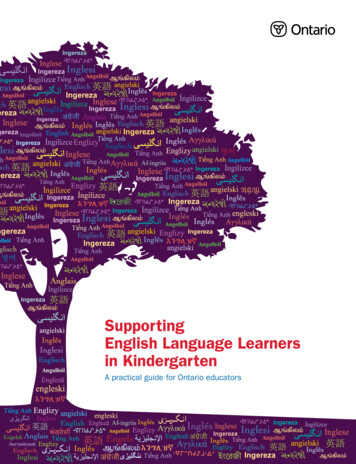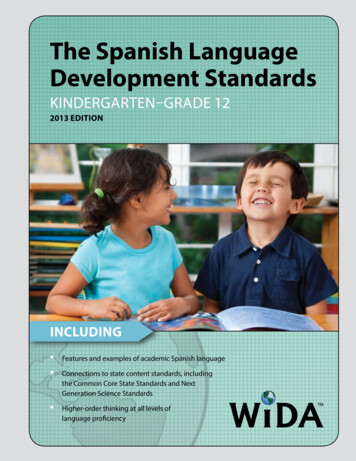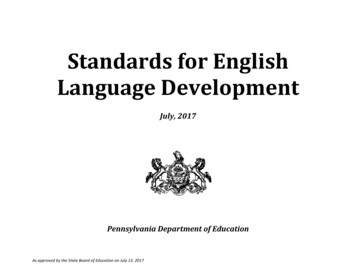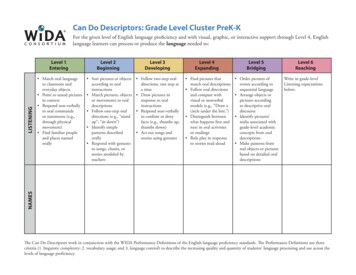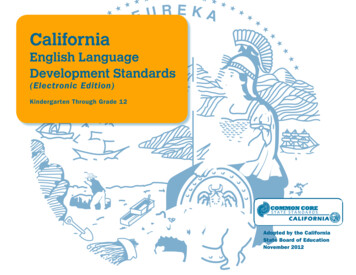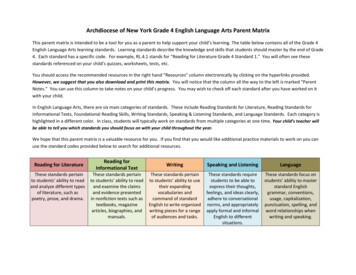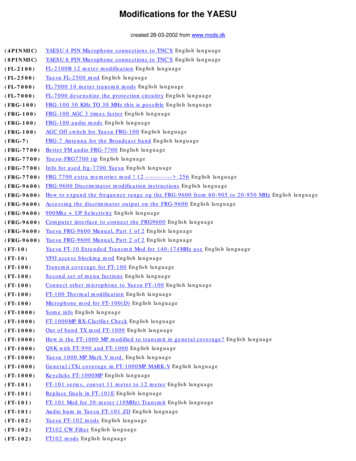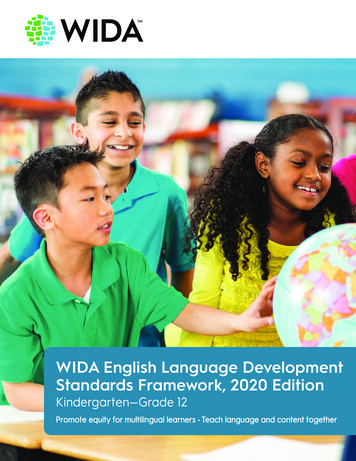
Transcription
WIDA English Language DevelopmentStandards Framework, 2020 EditionKindergarten—Grade 12Promote equity for multilingual learners Teach language and content together
Suggested citation:WIDA. (2020). WIDA English language development standards framework, 2020 edition: Kindergarten–grade 12.Board of Regents of the University of Wisconsin System. 2020 Board of Regents of the University of Wisconsin SystemWIDA is housed within the Wisconsin Center for Education Research at theUniversity of Wisconsin-MadisonVersion 1.5
WIDA English Language DevelopmentStandards Framework,2020 EditionKindergarten—Grade 12
The WIDA Consortium is a member-based organization made up of U.S. states,territories, and federal agencies dedicated to the research, design, and implementationof a high-quality, standards-based system for K-12 multilingual learners.WIDA Consortium MembersAlabamaAlaskaBureau of Indian EducationColoradoDelawareDistrict of ColumbiaDepartment of Defense Education issouriMontanaNevadaNew HampshireNew JerseyNew MexicoNorth CarolinaNorth DakotaNorthern Mariana IslandsOklahomaPennsylvaniaRhode IslandSouth CarolinaSouth DakotaTennesseeU.S. Virgin ngThe WIDA International School Consortium is a global network of 500 accredited preK12 independent schools in over 100 countries focused on educating multilingual learners.2WIDA English Language Development Standards Framework, 2020 Edition
ContentsIntroduction. . . . . . . . . . . . . . . . . . . . . . . . . . . . . . . . . . . . . . . . . . . . . . . . . . . . . . . . . . . . . . . . . . . . . . . . . . . . . . . . . . 7Welcome to the WIDA English Language Development Standards Framework, 2020 Edition . . . . . . . 9Section 1: Big Ideas . . . . . . . . . . . . . . . . . . . . . . . . . . . . . . . . . . . . . . . . . . . . . . . . . . . . . . . . . . . . . . . . . . . . . . . . . . 15Section 2: Understanding the WIDA ELD Standards Framework. . . . . . . . . . . . . . . . . . . . . . . . . . . . . . . . . . 21Section 3: Grade-Level Cluster Materials. . . . . . . . . . . . . . . . . . . . . . . . . . . . . . . . . . . . . . . . . . . . . . . . . . . . . . . 37Kindergarten . . . . . . . . . . . . . . . . . . . . . . . . . . . . . . . . . . . . . . . . . . . . . . . . . . . . . . . . . . . . . . . . . . . . . . . . . . . . 41Key Language Uses. . . . . . . . . . . . . . . . . . . . . . . . . . . . . . . . . . . . . . . . . . . . . . . . . . . . . . . . . . . . . . . . . . . . . . . 42Language Expectations, Functions, and Features . . . . . . . . . . . . . . . . . . . . . . . . . . . . . . . . . . . . . . . . . . . . 44Annotated Language Samples. . . . . . . . . . . . . . . . . . . . . . . . . . . . . . . . . . . . . . . . . . . . . . . . . . . . . . . . . . . . . 54Proficiency Level Descriptors. . . . . . . . . . . . . . . . . . . . . . . . . . . . . . . . . . . . . . . . . . . . . . . . . . . . . . . . . . . . . . 57Grade 1. . . . . . . . . . . . . . . . . . . . . . . . . . . . . . . . . . . . . . . . . . . . . . . . . . . . . . . . . . . . . . . . . . . . . . . . . . . . . . . . . . 61Key Language Uses. . . . . . . . . . . . . . . . . . . . . . . . . . . . . . . . . . . . . . . . . . . . . . . . . . . . . . . . . . . . . . . . . . . . . . . 62Language Expectations, Functions, and Features . . . . . . . . . . . . . . . . . . . . . . . . . . . . . . . . . . . . . . . . . . . . 64Annotated Language Samples. . . . . . . . . . . . . . . . . . . . . . . . . . . . . . . . . . . . . . . . . . . . . . . . . . . . . . . . . . . . . 75Proficiency Level Descriptors. . . . . . . . . . . . . . . . . . . . . . . . . . . . . . . . . . . . . . . . . . . . . . . . . . . . . . . . . . . . . . 79Grades 2-3. . . . . . . . . . . . . . . . . . . . . . . . . . . . . . . . . . . . . . . . . . . . . . . . . . . . . . . . . . . . . . . . . . . . . . . . . . . . . . . 83Key Language Uses. . . . . . . . . . . . . . . . . . . . . . . . . . . . . . . . . . . . . . . . . . . . . . . . . . . . . . . . . . . . . . . . . . . . . . . 84Language Expectations, Functions, and Features . . . . . . . . . . . . . . . . . . . . . . . . . . . . . . . . . . . . . . . . . . . . 86Annotated Language Samples. . . . . . . . . . . . . . . . . . . . . . . . . . . . . . . . . . . . . . . . . . . . . . . . . . . . . . . . . . . . . 98Proficiency Level Descriptors. . . . . . . . . . . . . . . . . . . . . . . . . . . . . . . . . . . . . . . . . . . . . . . . . . . . . . . . . . . . . . 101Grades 4-5 . . . . . . . . . . . . . . . . . . . . . . . . . . . . . . . . . . . . . . . . . . . . . . . . . . . . . . . . . . . . . . . . . . . . . . . . . . . . . 105Key Language Uses. . . . . . . . . . . . . . . . . . . . . . . . . . . . . . . . . . . . . . . . . . . . . . . . . . . . . . . . . . . . . . . . . . . . . . . 106Language Expectations, Functions, and Features . . . . . . . . . . . . . . . . . . . . . . . . . . . . . . . . . . . . . . . . . . . . 108Annotated Language Samples. . . . . . . . . . . . . . . . . . . . . . . . . . . . . . . . . . . . . . . . . . . . . . . . . . . . . . . . . . . . . 129Proficiency Level Descriptors. . . . . . . . . . . . . . . . . . . . . . . . . . . . . . . . . . . . . . . . . . . . . . . . . . . . . . . . . . . . . . 135Grades 6-8 . . . . . . . . . . . . . . . . . . . . . . . . . . . . . . . . . . . . . . . . . . . . . . . . . . . . . . . . . . . . . . . . . . . . . . . . . . . . . 139Key Language Uses. . . . . . . . . . . . . . . . . . . . . . . . . . . . . . . . . . . . . . . . . . . . . . . . . . . . . . . . . . . . . . . . . . . . . . . 140Language Expectations, Functions, and Features . . . . . . . . . . . . . . . . . . . . . . . . . . . . . . . . . . . . . . . . . . . . 142Annotated Language Samples. . . . . . . . . . . . . . . . . . . . . . . . . . . . . . . . . . . . . . . . . . . . . . . . . . . . . . . . . . . . . 164Proficiency Level Descriptors. . . . . . . . . . . . . . . . . . . . . . . . . . . . . . . . . . . . . . . . . . . . . . . . . . . . . . . . . . . . . . 171Grades 9-12. . . . . . . . . . . . . . . . . . . . . . . . . . . . . . . . . . . . . . . . . . . . . . . . . . . . . . . . . . . . . . . . . . . . . . . . . . . . . 177Key Language Uses. . . . . . . . . . . . . . . . . . . . . . . . . . . . . . . . . . . . . . . . . . . . . . . . . . . . . . . . . . . . . . . . . . . . . . . 178Language Expectations, Functions, and Features . . . . . . . . . . . . . . . . . . . . . . . . . . . . . . . . . . . . . . . . . . . . 180Annotated Language Samples. . . . . . . . . . . . . . . . . . . . . . . . . . . . . . . . . . . . . . . . . . . . . . . . . . . . . . . . . . . . 202Proficiency Level Descriptors. . . . . . . . . . . . . . . . . . . . . . . . . . . . . . . . . . . . . . . . . . . . . . . . . . . . . . . . . . . . . 209Section 4: Resources. . . . . . . . . . . . . . . . . . . . . . . . . . . . . . . . . . . . . . . . . . . . . . . . . . . . . . . . . . . . . . . . . . . . . . . . 215Key Language Uses: A Closer Look. . . . . . . . . . . . . . . . . . . . . . . . . . . . . . . . . . . . . . . . . . . . . . . . . . . . . . . . . 217Collaborative Planning for Content and Language Integration: A Jump-Off Point forCurricular Conversations . . . . . . . . . . . . . . . . . . . . . . . . . . . . . . . . . . . . . . . . . . . . . . . . . . . . . . . . . . . . . . 234Glossary . . . . . . . . . . . . . . . . . . . . . . . . . . . . . . . . . . . . . . . . . . . . . . . . . . . . . . . . . . . . . . . . . . . . . . . . . . . . . . . . 2513
Appendices . . . . . . . . . . . . . . . . . . . . . . . . . . . . . . . . . . . . . . . . . . . . . . . . . . . . . . . . . . . . . . . . . . . . . . . . . . . . . . . . 261Appendix A: WIDA English Language Development Standards Framework, 2020Edition—Meeting ESSA Title 1 Requirements . . . . . . . . . . . . . . . . . . . . . . . . . . . . . . . . . . . . . . . . . . . . . 263Appendix B: Correspondence Tables for Content and Language Standards . . . . . . . . . . . . . . . . . . . 266Appendix C: A Compilation of K-12 Key Language Use Distribution Tables and LanguageExpectations. . . . . . . . . . . . . . . . . . . . . . . . . . . . . . . . . . . . . . . . . . . . . . . . . . . . . . . . . . . . . . . . . . . . . . . . . 288Appendix D: A Compilation of K-12 Proficiency Level Descriptors, with Technical Notes. . . . . . . . . 329Appendix E: High-Level Comparison of WIDA Standards Editions From 2004 to 2020 . . . . . . . . . . . 351Appendix F: Theoretical Foundations of the WIDA ELD Standards Framework, 2020 Edition. . . . . 354Appendix G: Select References. . . . . . . . . . . . . . . . . . . . . . . . . . . . . . . . . . . . . . . . . . . . . . . . . . . . . . . . . . . 375Appendix H: Standards Development Process and Acknowledgements. . . . . . . . . . . . . . . . . . . . . . . 379TablesTable 1-1: WIDA ELD Standards Statements. . . . . . . . . . . . . . . . . . . . . . . . . . . . . . . . . . . . . . . . . . . . . . . . . . . . . . . . 9Table 1-2: Organization of the WIDA ELD Standards Framework, 2020 Edition. . . . . . . . . . . . . . . . . . . . . . . 10Table 1-3: Audience and Potential Uses of the WIDA ELD Standards Framework, 2020 Edition. . . . . . . . . 13Table 2-1: Abbreviated forms of the Five English Language Development Standards Statements. . . . . . 24Table 2-2: The Anatomy of a Language Expectation. . . . . . . . . . . . . . . . . . . . . . . . . . . . . . . . . . . . . . . . . . . . . . 30Table 2-3: Dimensions of Language in the Proficiency Level Descriptors: Criteria Fociand Sample Language Features. . . . . . . . . . . . . . . . . . . . . . . . . . . . . . . . . . . . . . . . . . . . . . . . . . . . . . . . . . . . 33Table 2-4: What the WIDA ELD Standards Framework is and What It Is Not. . . . . . . . . . . . . . . . . . . . . . . . . 35Table 3-1: Representations of the Components of the WIDA ELD Standards Framework inGrade-Level Cluster Materials . . . . . . . . . . . . . . . . . . . . . . . . . . . . . . . . . . . . . . . . . . . . . . . . . . . . . . . . . . . . . 40Table 3-2: Snapshots of Key Language Uses in Kindergarten. . . . . . . . . . . . . . . . . . . . . . . . . . . . . . . . . . . . . . 42Table 3-3: Distribution of Key Language Uses in Kindergarten . . . . . . . . . . . . . . . . . . . . . . . . . . . . . . . . . . . 43Table 3-4: Snapshots of Key Language Uses in Grade 1. . . . . . . . . . . . . . . . . . . . . . . . . . . . . . . . . . . . . . . . . . . 62Table 3-5: Distribution of Key Language Uses in Grade 1 . . . . . . . . . . . . . . . . . . . . . . . . . . . . . . . . . . . . . . . . 63Table 3-6: Snapshots of Key Language Uses in Grades 2-3 . . . . . . . . . . . . . . . . . . . . . . . . . . . . . . . . . . . . . . . 84Table 3-7: Distribution of Key Language Uses in Grades 2-3 . . . . . . . . . . . . . . . . . . . . . . . . . . . . . . . . . . . . . 85Table 3-8: Snapshots of Key Language Uses in Grades 4-5. . . . . . . . . . . . . . . . . . . . . . . . . . . . . . . . . . . . . . . 106Table 3-9: Distribution of Key Language Uses in Grades 4-5 . . . . . . . . . . . . . . . . . . . . . . . . . . . . . . . . . . . . . 107Table 3-10: Snapshots of Key Language Uses in Grades 6-8. . . . . . . . . . . . . . . . . . . . . . . . . . . . . . . . . . . . . . . 140Table 3-11: Distribution of Key Language Uses in Grades 6-8 . . . . . . . . . . . . . . . . . . . . . . . . . . . . . . . . . . . . . 141Table 3-12: Snapshots of Key Language Uses in Grades 9-12 . . . . . . . . . . . . . . . . . . . . . . . . . . . . . . . . . . . . . . 178Table 3-13: Distribution of Key Language Uses in Grades 9-12 . . . . . . . . . . . . . . . . . . . . . . . . . . . . . . . . . . . . 179Table 4-1: Definitions of Key Language Uses . . . . . . . . . . . . . . . . . . . . . . . . . . . . . . . . . . . . . . . . . . . . . . . . . . . . 219Table 4-2: Narrate Genre Family . . . . . . . . . . . . . . . . . . . . . . . . . . . . . . . . . . . . . . . . . . . . . . . . . . . . . . . . . . . . . . 222Table 4-3: Narrate Through the Years of Schooling . . . . . . . . . . . . . . . . . . . . . . . . . . . . . . . . . . . . . . . . . . . . . 223Table 4-4: Narrate Across Content Areas. . . . . . . . . . . . . . . . . . . . . . . . . . . . . . . . . . . . . . . . . . . . . . . . . . . . . . 2244WIDA English Language Development Standards Framework, 2020 Edition
Table 4-5: Inform Genre Family . . . . . . . . . . . . . . . . . . . . . . . . . . . . . . . . . . . . . . . . . . . . . . . . . . . . . . . . . . . . . . . 225Table 4-6: Inform Through the Years of Schooling . . . . . . . . . . . . . . . . . . . . . . . . . . . . . . . . . . . . . . . . . . . . . . 226Table 4-7: Inform Across Content Areas . . . . . . . . . . . . . . . . . . . . . . . . . . . . . . . . . . . . . . . . . . . . . . . . . . . . . . . 227Table 4-8: Explain Genre Family. . . . . . . . . . . . . . . . . . . . . . . . . . . . . . . . . . . . . . . . . . . . . . . . . . . . . . . . . . . . . . . 228Table 4-9: Explain Through the Years of Schooling. . . . . . . . . . . . . . . . . . . . . . . . . . . . . . . . . . . . . . . . . . . . . . 229Table 4-10: Explain Across Content Areas. . . . . . . . . . . . . . . . . . . . . . . . . . . . . . . . . . . . . . . . . . . . . . . . . . . . . . 230Table 4-11: Argue Genre Family . . . . . . . . . . . . . . . . . . . . . . . . . . . . . . . . . . . . . . . . . . . . . . . . . . . . . . . . . . . . . . . . 231Table 4-12: Argue Through the Years of Schooling . . . . . . . . . . . . . . . . . . . . . . . . . . . . . . . . . . . . . . . . . . . . . . 232Table 4-13: Argue Across Content Areas. . . . . . . . . . . . . . . . . . . . . . . . . . . . . . . . . . . . . . . . . . . . . . . . . . . . . . . 233Table 4-14: The Unit’s Academic Content and WIDA ELD Standards. . . . . . . . . . . . . . . . . . . . . . . . . . . . . . . 239Table 4-15: Sample Content Unit Architecture. . . . . . . . . . . . . . . . . . . . . . . . . . . . . . . . . . . . . . . . . . . . . . . . . . 240Table 4-16: Progress Trackers, Reading Informational Text, Driving Question Boards, and BuildingUnderstanding. . . . . . . . . . . . . . . . . . . . . . . . . . . . . . . . . . . . . . . . . . . . . . . . . . . . . . . . . . . . . . . . . . . . . . . . . . . 241Table 4-17: Language Expectations with Embedded Language Functions . . . . . . . . . . . . . . . . . . . . . . . . . 244Table 4-18: Example Language Features that are Commonly Associated with a Language Function. . 245Table A-1: Critical Elements in Meeting ESSA Title 1 Requirements . . . . . . . . . . . . . . . . . . . . . . . . . . . . . . . . 263Table D-1: Comparison of Criteria in 2014 Features of Academic Language Chartand 2020 Dimensions of Language Table. . . . . . . . . . . . . . . . . . . . . . . . . . . . . . . . . . . . . . . . . . . . . . . . . . . 329Table D-2: Differences Between Performance Definitions and Proficiency Level Descriptors . . . . . . . . 332Table E-1: Comparison of Editions of the WIDA Language Standards. . . . . . . . . . . . . . . . . . . . . . . . . . . . . . 352Table F-1: Updated Abbreviations for the WIDA ELD Standards, 2020 Edition. . . . . . . . . . . . . . . . . . . . . . . 361Table F-2: The Dimensions of Language: A Short Reference. . . . . . . . . . . . . . . . . . . . . . . . . . . . . . . . . . . . . . 367Table H-1: SEA Standards Subcommittee Members (2018-2020). . . . . . . . . . . . . . . . . . . . . . . . . . . . . . . . . . 380Table H-2: LEA Advisory Committee Members . . . . . . . . . . . . . . . . . . . . . . . . . . . . . . . . . . . . . . . . . . . . . . . . . 380Table H-3: October 2019 Focus Group Participants, WIDA Annual Conference. . . . . . . . . . . . . . . . . . . . . . 381Table H-4: Researcher/Teacher Advisory Panel (April 2020) . . . . . . . . . . . . . . . . . . . . . . . . . . . . . . . . . . . . . 383Table H-5: Domestic and International Educators. . . . . . . . . . . . . . . . . . . . . . . . . . . . . . . . . . . . . . . . . . . . . . . 384Table H-6: WIDA Standards Development Team. . . . . . . . . . . . . . . . . . . . . . . . . . . . . . . . . . . . . . . . . . . . . . . . 386FiguresFigure 1-1: Big Ideas in the 2020 Edition. . . . . . . . . . . . . . . . . . . . . . . . . . . . . . . . . . . . . . . . . . . . . . . . . . . . . . . . . . 17Figure 2-1: The Components of the WIDA ELD Standards Framework . . . . . . . . . . . . . . . . . . . . . . . . . . . . . . 23Figure 2-2: Relationship among the WIDA ELD Standards. . . . . . . . . . . . . . . . . . . . . . . . . . . . . . . . . . . . . . . . . 25Figure 2-3: Four Key Language Uses. . . . . . . . . . . . . . . . . . . . . . . . . . . . . . . . . . . . . . . . . . . . . . . . . . . . . . . . . . . . 26Figure 2-4: Example Reference Code for a Language Expectation. . . . . . . . . . . . . . . . . . . . . . . . . . . . . . . . . 28Figure 2-5: Modes of Communication . . . . . . . . . . . . . . . . . . . . . . . . . . . . . . . . . . . . . . . . . . . . . . . . . . . . . . . . . . 29Figure 2-6: Dimensions of Language within a Sociocultural Context . . . . . . . . . . . . . . . . . . . . . . . . . . . . . . . 32Figure 3-1: Kindergarten Language Functions and Language Features . . . . . . . . . . . . . . . . . . . . . . . . . . . . . 45Figure 3-2: Grade 1 Language Functions and Language Features. . . . . . . . . . . . . . . . . . . . . . . . . . . . . . . . . . 655
Figure 3-3: Grades 2-3 Language Functions and Language Features. . . . . . . . . . . . . . . . . . . . . . . . . . . . . . . . 87Figure 3-4: Grades 4-5 Language Functions and Language Features. . . . . . . . . . . . . . . . . . . . . . . . . . . . . . . 109Figure 3-5: Grades 6-8 Language Functions and Language Features. . . . . . . . . . . . . . . . . . . . . . . . . . . . . . . 143Figure 3-6: Grades 9-12 Language Functions and Language Features. . . . . . . . . . . . . . . . . . . . . . . . . . . . . . 181Figure 4-1: The Four Key Language Uses. . . . . . . . . . . . . . . . . . . . . . . . . . . . . . . . . . . . . . . . . . . . . . . . . . . . . . . . 217Figure 4-2: Sample Collaborative Planning Process. . . . . . . . . . . . . . . . . . . . . . . . . . . . . . . . . . . . . . . . . . . . . 237Figure 4-3: Honing a Language Focus through the WIDA ELD Standards Framework. . . . . . . . . . . . . . . 246Figure 4-4: Lesson Planning Considerations. . . . . . . . . . . . . . . . . . . . . . . . . . . . . . . . . . . . . . . . . . . . . . . . . . . . 249Figure D-1: Cumulative Expansion of Multilingual Learners’ Linguistic Resources. . . . . . . . . . . . . . . . . . . . 331Figure E-1: Editions of the WIDA Language Standards. . . . . . . . . . . . . . . . . . . . . . . . . . . . . . . . . . . . . . . . . . . . 351Figure F-1: Four Big Ideas in WIDA ELD Standards Framework, 2020 Edition. . . . . . . . . . . . . . . . . . . . . . . 355Figure F-2: Communication Modes Used in WIDA 2020 Edition. . . . . . . . . . . . . . . . . . . . . . . . . . . . . . . . . . . 358Figure F-3: The WIDA ELD Standards Framework, 2020 Edition. . . . . . . . . . . . . . . . . . . . . . . . . . . . . . . . . . . 360Figure F-4: Relationship among the WIDA ELD Standards. . . . . . . . . . . . . . . . . . . . . . . . . . . . . . . . . . . . . . . . 362Figure F-5: Key Language Uses. . . . . . . . . . . . . . . . . . . . . . . . . . . . . . . . . . . . . . . . . . . . . . . . . . . . . . . . . . . . . . . 363Figure F-6: Elements within WIDA Language Expectations. . . . . . . . . . . . . . . . . . . . . . . . . . . . . . . . . . . . . . . 364Figure F-7: WIDA ELD Standards Framework: Relationship between Language Expectations,Language Functions, and Language Features. . . . . . . . . . . . . . . . . . . . . . . . . . . . . . . . . . . . . . . . . . . . . . . . 3656WIDA English Language Development Standards Framework, 2020 Edition
Introduction
Welcome to the WIDA English LanguageDevelopment Standards Framework, 2020 EditionWIDA has historically grounded its work in language development standards as a driver of equity formultilingual learners in curriculum, instruction, and assessment. This new edition reflects a continuedcommitment to these goals.Starting in 2004, all editions of the WIDA English Language Development (ELD) Standards havereflected the belief that multilingual learners are best served when they learn content and languagetogether in linguistically and culturally sustaining ways. The 2020 Edition recommits to this beliefby maintaining the five original WIDA ELD Standards Statements while adding new and expandedresources to address updates in policy, theory, and practice.Table 1-1: WIDA ELD Standards StatementsWIDA ELD Standards StatementsEnglish Language Development Standard 1: English language learners communicate for Socialand Instructional purposes within the school settingEnglish Language Development Standard 2: English language learners communicate information,ideas, and concepts necessary for academic success in the content area of Language ArtsEnglish Language Development Standard 3: English language learners communicate information,ideas, and concepts necessary for academic success in the content area of MathematicsEnglish Language Development Standard 4: English language learners communicateinformation, ideas, and concepts necessary for academic success in the content area of ScienceEnglish Language Development Standard 5: English language learners communicate information,ideas, and concepts necessary for academic success in the content area of Social StudiesIntroduction9
The 2020 Edition presents a new supporting organization for the WIDA ELD Standard Statements, alongwith additional resources, as shown in Table 1-2.Table 1-2: Organization of the WIDA ELD Standards Framework, 2020 Edition Section 1:Big Ideas Section 2:Understandingthe WIDA ELDStandardsFrameworkSection 3:Grade-LevelClusterMaterials Section 4:Resources Appendices10Equity of access and opportunity are essential for multilinguallearners’ preparation for college, career, and civic participationIntegration of language and content is critical in the planning anddelivery of instructionCollaboration among stakeholders is a shared responsibility foreducating multilingual learnersA functional approach to language development focuses on thepurposeful use of languageThe five WIDA ELD Standards Statements—conceptual framing oflanguage and content integrationKey Language Uses—prominent language uses across disciplinesLanguage Expectations—goals for content-driven language learningProficiency Level Descriptors—a continuum of languagedevelopmentRepresentations of the WIDA ELD Standards Framework in sets ofgrade-level cluster materialsAnnotated Language Samples illustrate the WIDA ELD StandardsFramework in authentic grade-level textsKey Language Uses: A Closer Look—extended definitions andexamples for each Key Language UseCollaborative Planning for Content and Language Integration:A Jump-Off Point for Curricular ConversationsGlossaryA. Meeting ESSA RequirementsB. Correspondence Tables for Content and Language StandardsC. A Compilation of K-12 Key Language Use Distribution Tables andLanguage ExpectationsD. A Compilation of K-12 Proficiency Level Descriptors, with TechnicalNotesE. High Level Comparison of WIDA ELD Standards EditionsF. Theoretical FoundationsG. ReferencesH. AcknowledgementsWIDA English Language Development Standards Framework, 2020 Edition
WIDA Mission, Vision, and ValuesWIDA draws its strength from its mission, vision, and values—the Can Do Philosophy, innovation, service,collaboration, and social justice. This belief system underscores the cultural, social, emotional, andexperiential assets of multilingual learners, their families, and educators. It acts as a unifying forcethat gives the consortium its strength of conviction and action throughout the PreK-12 educationcommunity.MissionWIDA advances academiclanguage development andacademic achievement forchildren and youth who areculturally and linguisticallydiverse through high qualitystandards, assessments, research,and professional learning foreducators.From English Language Learners to Multilingual LearnersMultilingual learnersrefers to all childrenand youth who are, orhave been, consistentlyexposed to multiplelanguages.As part of its asset-based belief system, WIDA uses the term“multilingual learners” to describe all students who come incontact with and/or interact in languages in addition to Englishon a regular basis. They include students who are commonlyreferred to as English language learners (ELLs), dual languagelearners (DLLs), newcomers, students with interrupted formalschooling (SIFE), long-term English learners (L-TELs), Englishlearners with disabilities, gifted and talented English learners,heritage language learners, students with English as anadditional language (EAL), and students who speak varieties ofEnglish or indigenous languages.Throughout the field of K-12 education, you will encounter various terms to describe multilinguallearners. For example, ESSA (2015) uses the term “English learners” (ELs). For policy purposes, thefive original WIDA ELD Standards Statements (2004) maintain the term “English language learners.”However, in an effort to encourage the field to use terminology that is asset-based and inclusive, WIDAbegan to use the term “multilingual learners.” You will see this term used throughout this document,starting with the Guiding Principles of Language Development on the next page.Introduction11
WIDA Guiding Principles of Language Development (2019)The updated Guiding Principles of Language Development exemplify the overarching and ever-presentWIDA Can Do Philosophy and emphasize the importance of language in learning. They highlight thefour Big Ideas of the 2020 Edition.1.Multilingual learners’ languages and cultures are valuable resources to be leveraged for schoolingand classroom life; leveraging these assets and challenging biases help develop multilinguallearners’ independence and encourage their agency in learning.2.Multilingual learners’ development of multiple languages enhances their knowledge and culturalbases, their intellectual capacities, and their flexibility in language use.3.Multilingual learners’ language development and learning occur over time through meaningfulengagement in activities that are valued in their homes, schools, and communities.4. Multilingual learners’ language, social-emotional, and cognitive development are inter-relatedprocesses that contribute to their success in school and beyond.5.Multilingual learners use and develop language when opportunities for learning take into accounttheir individual experiences, characteristics, abilities, and levels of language proficiency.6.Multilingual learners use and develop language through activities which intentionally integratemultiple modalities, including oral, written, visual, and kinesthetic modes of communication.7.Multilingual learners use and develop language to interpret and access information, ideas, andconcepts from a variety of sources, including real-life objects, models, representations, andmultimodal texts.8.Multilingual learners draw on their metacognitive, metalinguistic, and metacultural awareness todevelop effectiveness in language use.9.Multilingual learners use their full linguistic repertoire, including translanguaging practices, toenrich their language development and learning.10. Multilingual learners use and develop language to interpret and present different perspectives,build awareness of relationships, and affirm their Hello!Hello!Hello!12WIDA English Language Development Standards Framework, 2020 EditionHello!
Audiences and Potential Uses of the WIDA ELD Standards Framework,2020 EditionThe 2020 Edition of the WIDA ELD Standards Framework is designed for U.S. and internationalaudiences. Table 1-3 outlines an array of uses for the document. While you will notice some overlap, wehave placed emphasis on the distinct nature and responsibilities of each group and its contribution tothe education of multilingual learners.Table 1-3: Audience and Potential Uses of the WIDA ELD Standards Framework, 2020 EditionAudiencePotential Uses of the WIDA ELD Standards Framework, 2020 EditionState,Territory,and FederalEducationAgencies,known asSEAs Districtand SchoolLeaders Teachers Comply with federal policy, including peer review requirements, andother state mandatesEnsure alignment with ACCESS for ELLs, the WIDA annual Englishlanguage proficiency assessmentGuide state policy, informational documents, and resources inclusive ofequity for multilingual learners and their familiesOrganize professional learning opportunities for educators ofmultilingual learnersGuide local policy, informational documents, and resourcesGuide professional learningWork with teachers, other school leaders, and families to prov
Table 3-5: Distribution of Key Language Uses in Grade 1 63. Table 3-6: Snapshots of Key Language Uses in Grades 2-3 84. Table 3-7: Distribution of Key Language Uses in Grades 2-3 85. Table 3-8: Snapshots of Key Language Uses in Grades 4-5 106. Table 3-9: Distributio
